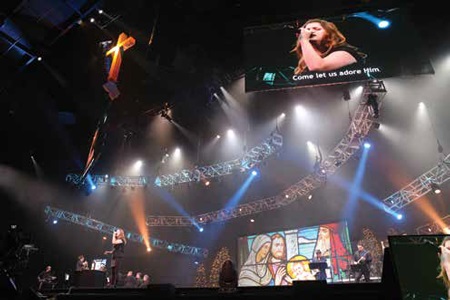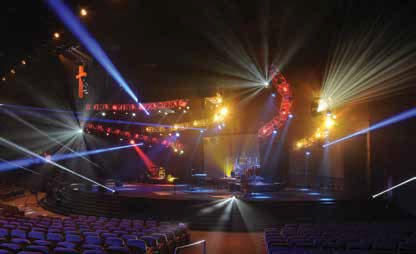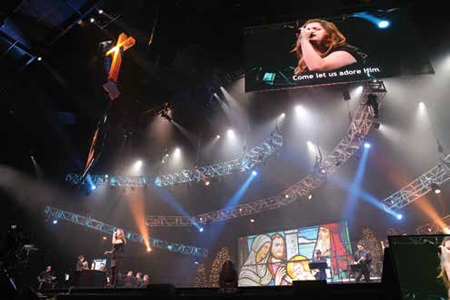“You’ll fit right in” is a promise that Hope Church makes front and center on its website’s homepage. This Memphis, TN house of worship went above and beyond to back up that claim, welcoming parishioners with a major upgrade to its audio, video, and lighting that transformed their space.

For the video lighting baseline, 4Wall’s Damon Herbert divided Hope Church’s stage into approximately 60 different areas, then plotted the lights’ position to ensure consistent light and color across the stage. The center of Hope Church’s multifaceted campus is the large sanctuary, which boasts a spacious 5,000-seat capacity, but it was due for an overhaul in 2015. Collaborating with AV integrator Technical Innovation and lighting integrator 4Wall Entertainment Lighting, this Evangelical Presbyterian church reimagined the main room in a way that would bring its message sharply—and spectacularly—into focus.
“The church has to meet the world where the world is,” said Damon Herbert, Lighting Designer for 4Wall. “When you reach out with concerts and TV production, that creates the kind of excitement that makes people say, ‘Hey, I want to go there. I want to experience what that’s all about.’”
An unabashed fan of Rush, a band famed for immersive concerts, Herbert helped Hope Church assemble a touring-grade lighting rig that exceeded expectations while staying on budget.
For the video lighting baseline, Herbert divided Hope Church’s stage into approximately 60 different areas, then plotted the lights’ position to ensure consistent light and color across the stage. “The most complex thing about video is being very consistent,” Herbert confirms. “If you’re lighting ballet, for example, inconsistencies can be very interesting to the eye. But the cameras don’t like that: If a shadow starts moving around a person’s face when they’re walking onstage, that becomes distracting.”
Control for the lighting system came via a MA Lighting Dot2 console, and networking was achieved with two Pathport Octo eight-port rack mountable nodes, eight Pathport Nodes, and a Strand Lighting Vision.net integrated lighting management system.
With the lighting planned to work in tandem with the video production, Technical Innovation’s Joe Paryzek, senior video systems engineer, worked on overcoming other potential pitfalls. “The room presented many challenges resulting from building code requirements for the area, which dramatically reduced the planned height of the ceiling when the building was first constructed,” Paryzek explained. “The large floor space and low ceiling made sightlines and speaker placement difficult.”

Hope Church in Memphis wanted a tour-grade lighting design for its sanctuary, which was paired with video and audio systems designed and integrated by Technical Innovation. Using a hybrid of LED and rear projection—comprised of two primary presentation screens, and five secondary displays—Paryzek and his team created an expansive visual landscape.
“The two primary displays are Aeson LED walls flown on chain motors for service access,” said Paryzek. “The secondary Samsung LED displays are along the apron of the stage, so the front few rows—which are outside of the best sightlines of the LED walls—do not have to ‘look up’ to view the large LED screens. There is an additional rear-projection screen created by repurposing their existing two Christie projectors and ‘stacking’ them to form a brighter rear-screen display for the scenic background effects and lyrics.”
Audio was also a star in the Hope Church upgrade, thanks to an innovative system design overseen by Scott Clark, senior audio systems design engineer for Technical Innovation. Clark’s objective was to ensure a uniform sonic experience for every seat in the house—no small task in a 200-foot-deep fan-shaped room where the furthest corners are 330 feet apart, topped off with a 26-foot ceiling height.
Employing his own proprietary techniques, Clark implemented a system that provides a consistent stereo image across wide spaces like Hope Church, eschewing point source modules with delays for a more elegant solution. “I’m a fan of ‘simpler is better,’” Clark stated. “In this case, a line array is simpler because most of the sound is coming from one area, rather than spread out all over the room.”
Based on performance and cost, the optimal system proved to be 40 of the JBL VTX V20 speakers deployed in four arrays, bolstered by 12 JBL s28 subwoofers. Crown amps and BSS processing were selected, as well as a Midas PRO9 console—all capable, of an impressive 96 kHz sampling rate throughout. “If the source is clean, and the system is set up properly, 96k’s end result is less processed with a more natural and open sound,” Clark added.
David Weiss (www.dwords.com) writes extensively about AV, audio, and broadcast technology.
